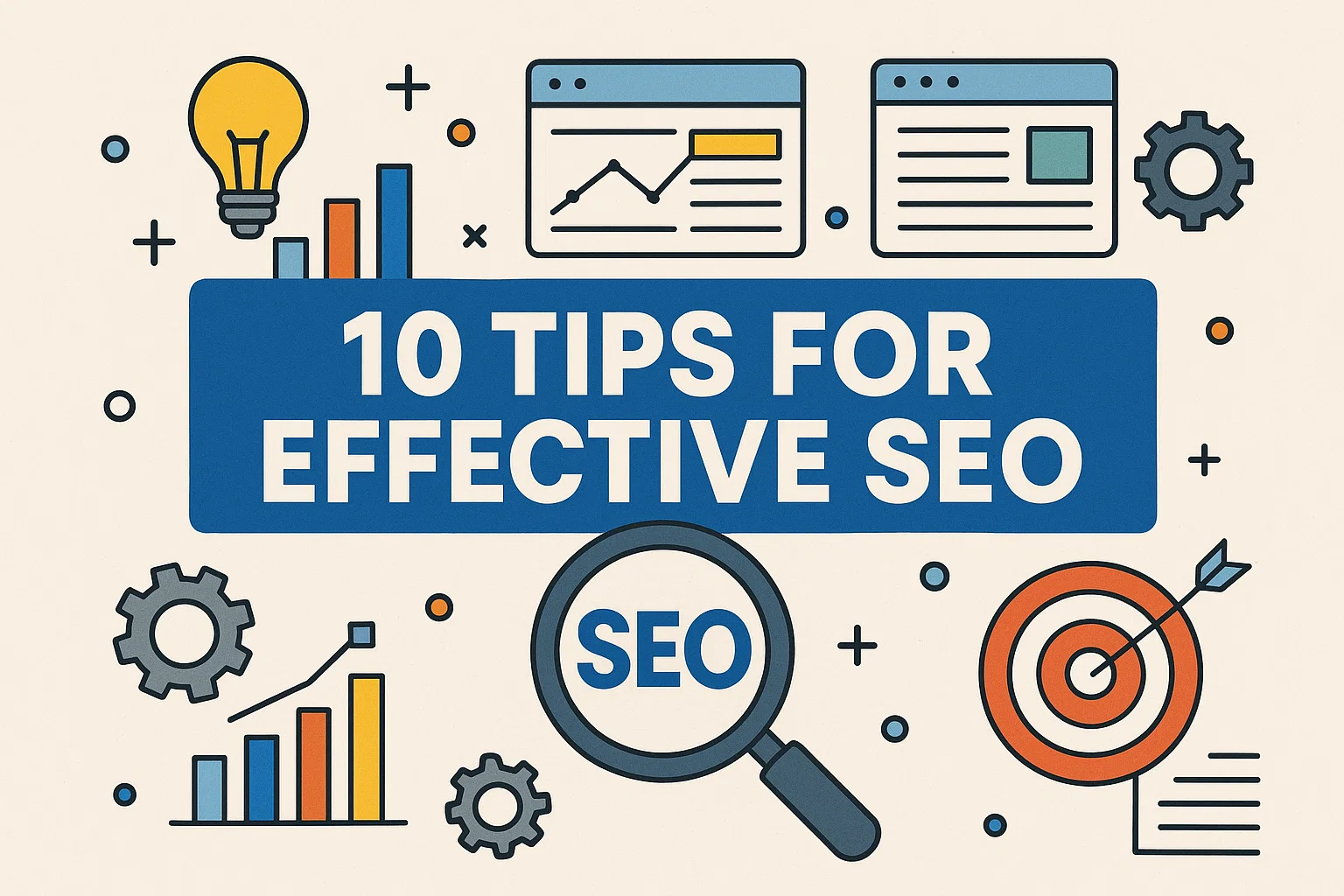10 Tips for Effective SEO That Actually Work
1. Optimize Page Titles and Meta Descriptions
Your page titles and meta descriptions are often the first thing users see in search results.
They need to be concise, relevant, and include your target keyword.
- Keep titles under 60 characters
- Place the keyword near the beginning
- Use natural language, not keyword stuffing
Meta descriptions don’t directly impact rankings, but they affect click-through rates.
A well-written meta can encourage more clicks, which sends positive engagement signals to search engines.
Use active language.
Highlight the benefit of clicking through.
Tools You Can Use
- Yoast SEO
- Rank Math
- Moz Title Tag Preview Tool
Common Mistakes to Avoid
- Repeating keywords
- Using the same title/meta on multiple pages
- Ignoring character limits
2. Use Targeted Keywords Naturally
Keyword use is still a pillar of SEO. But stuffing your content with them will do more harm than good.
Instead, focus on:
- Including your main keyword in the title, first 100 words, and headers
- Using related phrases (semantic keywords) throughout
- Writing in a way that feels human, not robotic
Google’s algorithm has evolved. It now understands context.
That means it rewards clear, useful writing over keyword-heavy pages.
Tools You Can Use
- Google Keyword Planner
- AnswerThePublic
- SEMrush
Common Mistakes to Avoid
- Forcing keywords into every paragraph
- Ignoring user intent
- Neglecting long-tail variations
3. Improve Page Loading Speed
Fast websites rank better.
Users abandon slow sites, which hurts bounce rates and engagement.
Speed matters more than ever.
Steps to improve it:
- Compress images
- Minify CSS, JS, and HTML
- Use a content delivery network (CDN)
- Choose reliable hosting
Use Google’s PageSpeed Insights to find what’s slowing you down.
Tools You Can Use
- PageSpeed Insights
- GTmetrix
- Cloudflare
Common Mistakes to Avoid
- Uploading uncompressed images
- Using too many third-party scripts
- Ignoring mobile load times
4. Ensure Mobile Responsiveness
Over half of web traffic comes from mobile devices.
If your site isn’t mobile-friendly, users will bounce—and Google notices.
Use a responsive design that adjusts to screen size.
Avoid small fonts and buttons that are hard to tap.
Mobile-first indexing means Google now evaluates mobile versions first.
Tools You Can Use
- Google Mobile-Friendly Test
- Responsive Design Checker
- BrowserStack
Common Mistakes to Avoid
- Not testing on multiple devices
- Using popups that cover content
- Overlooking page speed on mobile
5. Create High-Quality Content
Content still reigns supreme. But not just any content—helpful content.
It should:
- Answer real questions
- Be updated regularly
- Include facts, statistics, and visuals
- Be easy to read (short sentences, clear structure)
Google’s Helpful Content Update prioritizes content written for humans, not algorithms.
Write to solve a problem or satisfy a search query.
Tools You Can Use
- Grammarly
- Hemingway Editor
- SurferSEO
Common Mistakes to Avoid
- Writing for word count, not quality
- Duplicating existing content
- Ignoring search intent
6. Use Internal Linking Strategically
Internal links help users and search engines navigate your site.
They also distribute link equity across your pages.
Best practices:
- Link to relevant content naturally
- Use descriptive anchor text
- Don’t overdo it (2–5 internal links per 500 words is a good rule)
This also helps reduce bounce rate and increases time on site—both ranking signals.
Tools You Can Use
- Ahrefs Site Audit
- Screaming Frog SEO Spider
Common Mistakes to Avoid
- Using “click here” as anchor text
- Linking to irrelevant pages
- Over-linking in a single paragraph
7. Optimize Images for SEO
Images can boost engagement—but only if optimized.
Here’s how:
- Use descriptive file names and alt text
- Compress images to reduce load time
- Choose the right format (WebP or JPEG for most cases)
Alt text improves accessibility and helps search engines understand your content.
Tools You Can Use
- TinyPNG
- ImageOptim
- Squoosh
Common Mistakes to Avoid
- Missing or generic alt text
- Large image file sizes
- Decorative images with no value
8. Build Authoritative Backlinks
Backlinks are still a top ranking factor.
The more relevant, high-authority sites that link to you, the more trust you build with search engines.
Ways to earn backlinks:
- Create linkable assets (guides, tools, data)
- Outreach to relevant blogs and media
- Guest posting
Avoid shady link farms.
Quality matters more than quantity.
Tools You Can Use
- Ahrefs
- SEMrush Backlink Checker
- HARO (Help a Reporter Out)
Common Mistakes to Avoid
- Buying links
- Overusing exact-match anchor text
- Ignoring nofollow vs. dofollow distinctions
9. Focus on User Experience (UX)
Good UX keeps users engaged and reduces bounce rate.
Key UX elements:
- Fast loading speed
- Clear navigation
- Readable fonts and color contrast
- Clean design with proper white space
When people stay longer and click more, it tells Google your page is worth ranking.
Tools You Can Use
- Hotjar
- Crazy Egg
- Google Analytics
Common Mistakes to Avoid
- Cluttered pages
- Poor contrast
- Hidden CTAs
10. Monitor Performance and Adjust
SEO isn’t set-it-and-forget-it.
Regular monitoring lets you identify what’s working and fix what’s not.
Track:
- Organic traffic
- Bounce rate
- Keyword rankings
- Conversion rates
Use data to update your strategy over time.
Tools You Can Use
- Google Analytics
- Google Search Console
- Ubersuggest
Common Mistakes to Avoid
- Ignoring analytics
- Not A/B testing content
- Tracking vanity metrics only





